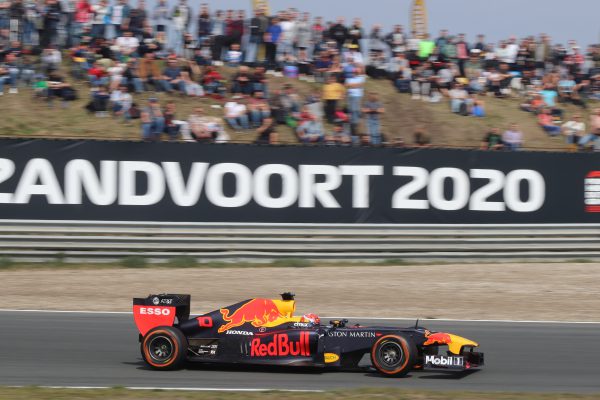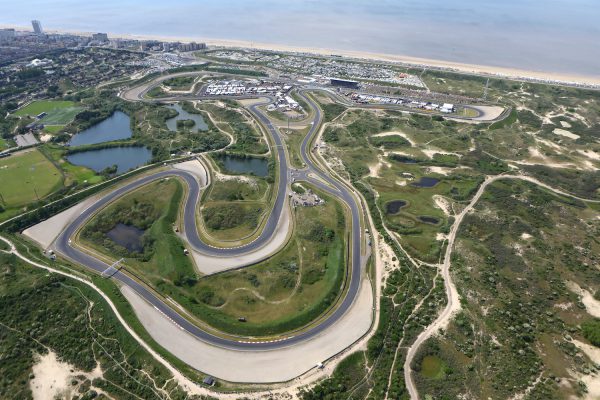The circuit
CM.com Circuit Zandvoort is not only known for its legendary races and fantastic atmosphere, the Zandvoort race track is also famous for its unique location. With the beach nearby and a dream course in the Zandvoort dunes, it is a feast for every racing fan to visit CM.com Circuit Zandvoort.
With a track length of 4.3 kilometers, it is one of the shorter circuits on the F1 calendar: hardly anywhere else do drivers race past the fans so often! Here you will not find endless run-off strips of asphalt, only relentless gravel pits. Any mistake on the circuit will be punished. The extremely challenging track has 14 turns and has been completely upgraded to the highest standards, while maintaining the unique character of CM.com Circuit Zandvoort.
History
The relationship between Zandvoort and motorsport takes us back to the late 1930s, when racing enthusiasts decided to organize a race in Zandvoort. The 1939 race was held on a temporary street circuit. After great success, it was decided to build a permanent circuit. The first race on that circuit was held on 7 August 1948. From 1952 Zandvoort was part of the Formula 1 calendar. In the 1970s, the circuit underwent a number of adjustments, including new safety provisions. The last F1 Grand Prix took place in 1985, as the company that owned the track went out of business. In 1999 the track was extended to a full GP length of 4.3 kilometers. For the re-invented F1 Dutch Grand Prix 2021, the circuit has been adjusted on a number of points, but the unique character has remained unaffected.
Heroes of the track
The list of Formula 1 heroes who have driven at CM.com Circuit Zandvoort is very long. One of the most legendary races was held in 1985, when Niki Lauda had to start from 10th place but fought his way to victory. On the podium, he was flanked by two other motorsport legends: Alain Prost and Ayrton Senna. The win at Zandvoort was also the last GP victory in Niki Lauda’s career. A large part of the current F1 starting field has achieved success at Zandvoort in Formula 3. Lewis Hamilton, Valtteri Bottas and Max Verstappen, for example, know what it is like to win at Zandvoort. With Verstappen’s 2021 win in the new F1 Grand Prix, F1 racing is back to stay in the Netherlands.
Positive economic and social impact of the F1 Grand Prix
In September 2021, the Formula 1 Heineken Dutch Grand Prix returned to the Netherlands. Tens of thousands of visitors traveled to CM.com Circuit Zandvoort and millions of people worldwide enjoyed it on tv or online. Friend and foe soon agreed: the event was a great success. Breda University of Applied Sciences (BUas) has completed a scientific study into the economic, social and societal impact of the event, which showed that the return of the event has had many positive effects on the region.
Economic impact
The Dutch Grand Prix has led to a lot of extra spending in Zandvoort and the region: €22.3 million in Zandvoort and €44.5 million in additional spending in the Amsterdam Metropolitan Area (MRA). This extra spending has created 244 jobs in Zandvoort and 498 jobs in the MRA region (including Zandvoort). It is striking that these figures, even with only two thirds of seat filled due to Covid restrictitions measures, are higher than the predictions from the Desicio survey of 2017.
Positive social and societal impact
Residents, entrepreneurs and visitors were unanimous about how they experienced the Dutch Grand Prix. Residents were impressed by the event (87.2%) and greatly enjoyed (88.9%) the return of Formula 1 to Zandvoort. Entrepreneurs were also pleased with the atmosphere in the village and in their company, giving a score of 8.7 for the atmosphere in the village and 8.4 for the atmosphere in their own businesses. Visitors also enjoyed the good atmosphere in Zandvoort: 93% enjoyed the good atmosphere in the village and 92% of visitors felt welcome.
Access and sustainability
The ambitious mobility plan of the Dutch Grand Prix has resulted in above-expected positive figures with regard to the sustainability requirement. The objective was to become a car-free event in three years, which was already largely achieved by 2021 with less than 5% of visitors reaching the final destination by car. Due to the distribution of visitors over various means of transport, the event remained very easily accessible and the inflow and outflow of visitors went well.
Written by Dutch GP

